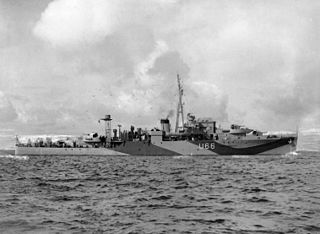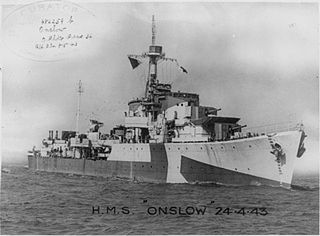
HX convoys were transatlantic convoys in the North Atlantic during the First World War and in the Battle of the Atlantic in the Second World War. HX convoys sailed eastwards from Halifax, Nova Scotia in Canada, to Liverpool and other ports in Britain. They were joined the BHX convoys from Bermuda en route. After the United States entered the war, HX convoys began at New York.

HMS Starling, pennant number U66, was a Modified Black Swan-class sloop of the Royal Navy. She was active in the Battle of the Atlantic during the Second World War and was the most successful anti-submarine warfare vessel of the Royal Navy, being credited with the destruction of fourteen U-boats.

This is a timeline for the Battle of the Atlantic (1939–1945) in World War II.

HMS Woodpecker, pennant number U08, was a Black Swan-class sloop of the Royal Navy. She was active during the Second World War and was a successful anti-submarine warfare vessel, being credited with the destruction of six U-boats.

HMS Onslow was an O-class destroyer of the Royal Navy. The O-class were intermediate destroyers, designed before the outbreak of the Second World War to meet likely demands for large number of destroyers. They had a main gun armament of four 4.7 in guns, and had a design speed of 36 kn. Onslow was ordered on 2 October 1939 and was built by John Brown & Company at their Clydebank, Glasgow shipyard, launching on 31 March 1941 and completing on 8 October 1941.

HMS Samphire was a Flower-class corvette that served in the Royal Navy.

The Shoreham-class sloops were a class of eight warships of the Royal Navy built in the early 1930s.

Convoy SC 94 was the 94th of the numbered series of World War II Slow Convoys of merchant ships from Sydney, Cape Breton Island, Nova Scotia, to Liverpool. The ships departed Sydney on 31 July 1942 and were met by Mid-Ocean Escort Force Group C-1.

Convoy SC 7 was the seventh of the SC convoys, bound from Sydney, Nova Scotia across the North Atlantic to British ports, mainly Liverpool. They were called SC as their departure point was designated Sydney, Cape Breton to avoid confusion with Sydney in Australia. The convoys formed part of the battle of the Atlantic during the Second World War. Large numbers of merchant ships travelled with naval escorts to protect against U-boat attacks. Th convoys were often slow, the merchantmen often only being capable of a speed of around 8 kn and so were particularly vulnerable to attack. This problem was exacerbated by a shortage of suitable escorts from either the Royal Canadian Navy or the Royal Navy early in the war.
HX 72 was a North Atlantic convoy of the HX series which ran during the battle of the Atlantic in World War II. The convoy comprised 43 ships of which 11 were sunk and another damaged by German U-boats who suffered no losses.

Convoy PQ 12 was an Arctic convoy sent from Great Britain by the Western Allies to aid the Soviet Union during World War II. It sailed in March 1942, reaching Murmansk despite a sortie against it by the German battleship Tirpitz. All ships arrived safely.
Convoy HX 90 was a North Atlantic convoy of the HX series in the Second World War which ran during the Battle of the Atlantic in both world wars.
HG 84 was an Allied convoy of the HG series during the Second World War.
Convoy HX 65 was a North Atlantic convoy of the HX series which ran during the battle of the Atlantic in World War II. It was the 65th of the numbered series of merchant convoys run by the Allies from Halifax to Liverpool. The convoy was attacked by German U-boats and aircraft, losing eight of its 51 ships sunk and a further three damaged. One U-boat was damaged.

Convoy HG 73 was a trade convoy of merchant ships during the Second World War. It was the 73rd of the numbered HG convoys Homeward bound to the British Isles from Gibraltar. The convoy departed Gibraltar on 17 September 1941 and was spotted by a German reconnaissance aircraft on 18 September. The convoywas attacked over the next ten days. Nine ships were sunk from the convoy before the submarines exhausted their torpedo inventory on 28 September. The convoy reached Liverpool on 1 October.

Convoy ON 92 was a trade convoy of merchant ships during the Second World War. It was the 92nd of the numbered series of ON convoys Outbound from the British Isles to North America. The ships departed from Liverpool on 6 May 1942 and were joined on 7 May by Mid-Ocean Escort Force Group A-3.
Convoy LN-7 was a trade convoy of merchant ships during the Second World War. It was one of the numbered LN convoys from Quebec City to Goose Bay, Labrador. The convoy was found on 2 September 1942 by U-517, which then destroyed the merchant ship Donald Stewart early the next morning.
Convoy HX 47 was a North Atlantic convoy of the HX series which ran during the battle of the Atlantic in World War II. It was the 47th of the numbered series of merchant convoys run by the Allies from Halifax to Liverpool. The convoy was attacked by German U-boats and lost three of its 58 ships.
Convoy HG 53 was the 53rd of the numbered series of World War II HG convoys of Homeward bound merchant ships from Gibraltar to Liverpool. Convoy HG 53 lost nine ships during a coordinated attack in February 1941. HG 53 was one of the few Atlantic convoys to have ships sunk by submarines, by aircraft, and by surface ships.

HMS Deptford was a Grimsby-class sloop of the British Royal Navy. Built at Chatham Dockyard in the 1930s, Deptford was launched in 1935 and commissioned later that year. The ship saw early service on the Persian Gulf station, but the outbreak of the Second World War saw Deptford serving as a convoy escort in the North Atlantic and the Mediterranean, sinking a German U-boat in 1941. She survived the war and was scrapped in 1948.











